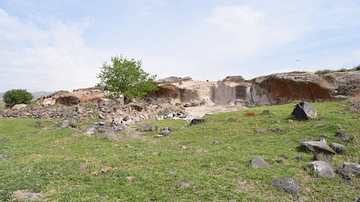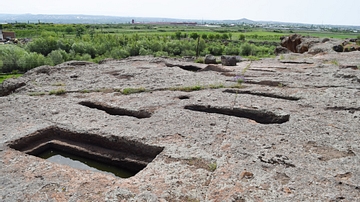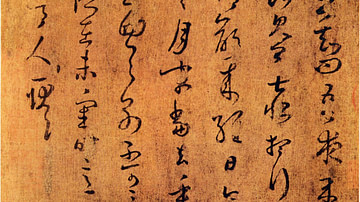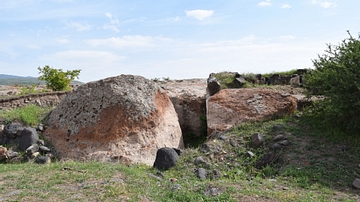Search Images
Browse Content (p. 1204)

Image
Terracotta Head from Mali's Inland Niger Delta Region
This terracotta head was made by an artist from the Inland Niger Delta Region of Mali. It dates from perhaps the 1300-1600s CE. (Art Gallery of Ontario, Toronto)

Image
Ancient Settlement at Agarak
The prehistoric and ancient settlement of Agarak in what is presently Armenia flourished from the early Bronze Age through the Middle Ages.

Image
Prehistoric Agarak Ruins
Agarak is an important archaeological site located in Armenia. It dates from the early Bronze Age, and excavations at the site have revealed large quantities of ceramic fragments and statuettes.

Image
Ancient Structure at Agarak, Armenia
The ruins of this ancient structure located at the Agarak archaeological site in Armenia date from the early Bronze Age.

Image
Outline of a Dwelling at Agarak
Excavations at Agarak in what is presently the Aragatsotn Province of Armenia reveal the outlines of streets and floor plans. In this picture, one can see the outline of a structure, which dates to the early Bronze Ages.

Image
Prehistoric Agarak in Armenia
Agarak is a large archaeological site in the Aragatsotn Province of Armenia. The site contains some of the oldest large man-made structures carved into stone, which date from the early Bronze Age.

Image
Calligraphy by Cai Xiang
An example of the calligraphy of Cai Xiang, an 11th century CE Chinese calligrapher. (National Palace Museum, Taipei, Taiwan)

Image
Stone Carved Indentations at Agarak
These indentations in stone found at the Agarak archaeological site were likely used for rituals involving wine and "holy water." They come in a variety of sizes and shapes. The ancients of Agarak believed these rites involving the use of...

Image
Calligraphy by Wang Xizhi
A portion of copied calligraphy originally by the famed Chinese calligrapher Wang Xizhi (c. 303 - c. 365 CE). Tang dynasty period.

Image
Ancient Agarak Ruins
Ruins at Agarak in what is modern Armenia. This archaeological site was inhabited by people for thousands of years through the Bronze Age, Iron Age, and Urartian period.